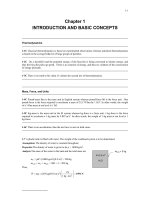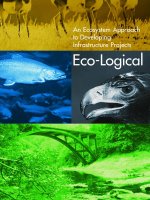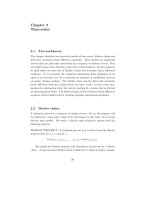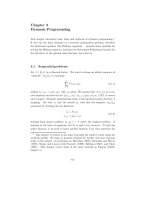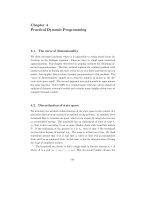Insect Ecology - An Ecosystem Approach 2nd ed - Chapter 1 docx
Bạn đang xem bản rút gọn của tài liệu. Xem và tải ngay bản đầy đủ của tài liệu tại đây (776.7 KB, 24 trang )
T
his second edition provides an updated and expanded synthesis of feedbacks and
interactions between insects and their environment.A number of recent studies have
advanced understanding of feedbacks or provided useful examples of principles. Mo-
lecular methods have provided new tools for addressing dispersal and interactions among
organisms and have clarified mechanisms of feedback between insect effects on, and
responses to, environmental changes. Recent studies of factors controlling energy and nutri-
ent fluxes have advanced understanding and prediction of interactions among organisms and
abiotic nutrient pools.
The traditional focus of insect ecology has provided valuable examples of adaptation to
environmental conditions and evolution of interactions with other organisms. By contrast,
research at the ecosystem level in the last 3 decades has addressed the integral role of her-
bivores and detritivores in shaping ecosystem conditions and contributing to energy and
matter fluxes that influence global processes. This text is intended to provide a modern per-
spective of insect ecology that integrates these two traditions to approach the study of insect
adaptations from an ecosystem context.This integration substantially broadens the scope of
insect ecology and contributes to prediction and resolution of the effects of current envi-
ronmental changes as these affect and are affected by insects.
This text demonstrates how evolutionary and ecosystem approaches complement each
other, and is intended to stimulate further integration of these approaches in experiments
that address insect roles in ecosystems. Both approaches are necessary to understand and
predict the consequences of environmental changes, including anthropogenic changes, for
insects and their contributions to ecosystem structure and processes (such as primary pro-
ductivity, biogeochemical cycling, carbon flux, and community dynamics). Effective manage-
ment of ecosystem resources depends on evaluation of the complex, often complementary,
effects of insects on ecosystem conditions as well as insect responses to changing conditions.
Two emerging needs require the integration of traditional and emerging perspectives of
insect roles in ecosystems. First, we are becoming increasingly aware that global environ-
PREFACE
xi
FM-P088772.qxd 1/24/06 11:11 AM Page xi
mental changes must be addressed from a global (rather than local) perspective,
with emphasis on integrating ecological processes at various levels of resolution
and across regional landscapes. Insect population structure, interactions with
other species, and effects on ecosystem processes are integral to explaining and
mitigating global changes. Second, the changing goals of natural resource man-
agement require a shift in emphasis from the traditional focus on insect–plant
interactions and crop “protection” to an integration of ecosystem components
and processes that affect sustainability of ecosystem conditions and products.
Integrated pest management (IPM) is founded on such ecological principles.
The hierarchical model, familiar to ecosystem ecologists and used in this text,
focuses on linkages and feedbacks among individual, population,community, and
ecosystem properties. This model contributes to integration of evolutionary and
ecosystem approaches by illustrating how properties at higher levels of resolu-
tion (e.g., the community or ecosystem) contribute to the environment perceived
at lower levels (e.g., populations and individuals) and how responses at lower
levels contribute to properties at higher levels of this hierarchy. Some overlap
among sections and chapters is necessary to emphasize linkages among levels.
Where possible, overlap is minimized through cross-referencing.
A number of colleagues have contributed enormously to my perspectives on
insect and ecosystem ecology. I am especially grateful to J.T. Callahan, J T. Chao,
S. L. Collins, R. N. Coulson, D. A. Crossley, Jr., R. Dame, D. A. Distler, L. R. Fox,
J. F. Franklin, F. B. Golley, J. R. Gosz, M. D. Hunter, F. Kozár, M. D. Lowman, G.
L. Lovett, H K. Luh, J. C. Moore, E. P. Odum, H. T. Odum, D. W. Roubik, T. R.
Seastedt, D. J. Shure, P. Turchin, R. B. Waide, W. G. Whitford, R. G. Wiegert, M.
R. Willig, and W J. Wu for sharing ideas, data, and encouragement. I also have
benefited from collaboration with colleagues at Louisiana State University and
Oregon State University and associated with U.S. Long Term Ecological
Research (LTER) sites, International LTER projects in Hungary and Taiwan, the
Smithsonian Tropical Research Institute, Wind River Canopy Crane Research
Facility, Teakettle Experimental Forest, USDA Forest Service Demonstration of
Ecosystem Management Options (DEMO) Project, USDA Western Regional
Project on Bark Beetle-Pathogen Interactions, and the National Science Foun-
dation. L. R. Fox, T. R. Seastedt, and M. R. Willig reviewed drafts of the previous
edition. Several anonymous reviewers provided useful comments addressed in
this edition. I also am indebted to C. Schowalter for encouragement and feed-
back. K. Sonnack, B. Siebert and H. Furrow at Elsevier provided valuable edito-
rial assistance. I am, of course, solely responsible for the selection and
organization of material in this book.
xii
PREFACE
FM-P088772.qxd 1/24/06 11:11 AM Page xii
1
Overview
I. Scope of Insect Ecology
II. Ecosystem Ecology
A. Ecosystem Complexity
B. The Hierarchy of Subsystems
C. Regulation
III. Environmental Change and Disturbance
IV. Ecosystem Approach to Insect Ecology
V. Scope of This Book
INSECTS ARE THE DOMINANT GROUP OF ORGANISMS ON EARTH, IN
terms of both taxonomic diversity (>50% of all described species) and ecological
function (E.Wilson 1992) (Fig. 1.1). Insects represent the vast majority of species
in terrestrial and freshwater ecosystems and are important components of near-
shore marine ecosystems as well. This diversity of insect species represents an
equivalent variety of adaptations to variable environmental conditions. Insects
affect other species (including humans) and ecosystem parameters in a variety of
ways. The capacity for rapid response to environmental change makes insects
useful indicators of change, major engineers and potential regulators of ecosys-
tem conditions, and frequent competitors with human demands for ecosystem
resources or vectors of human and animal diseases.
Insects also play critical roles in ecosystem function.They represent important
food resources or disease vectors for many other organisms, including humans,
and they have the capacity to alter rates and directions of energy and matter
fluxes (e.g., as herbivores, pollinators, detritivores, and predators) in ways that
potentially affect global processes. In some ecosystems, insects and other arthro-
pods represent the dominant pathways of energy and matter flow, and their bio-
mass may exceed that of the more conspicuous vertebrates (e.g.,Whitford 1986).
Some species are capable of removing virtually all vegetation from a site. They
affect, and are affected by, environmental issues as diverse as ecosystem health,
air and water quality, genetically modified crops, disease epidemiology, frequen-
cy and severity of fire and other disturbances, control of invasive exotic species,
land use, and climate change. Environmental changes, especially those resulting
from anthropogenic activities, affect abundances of many species in ways that
alter ecosystem and, perhaps, global processes.
A primary challenge for insect ecologists is to place insect ecology in an
ecosystem context that represents insect effects on ecosystem properties, as well
1
001-P088772.qxd 1/24/06 10:31 AM Page 1
as the diversity of their adaptations and responses to environmental conditions.
Until relatively recently, insect ecologists have focused on the evolutionary sig-
nificance of insect life histories and interactions with other species, especially as
pollinators, herbivores, and predators (Price 1997). This focus has yielded much
valuable information about the ecology of individual species and species associ-
ations and provides the basis for pest management or recovery of threatened and
endangered species. However, relatively little attention has been given to the
important role of insects as ecosystem engineers, other than to their effects on
vegetation (especially commercial crop) or animal (especially human and live-
stock) dynamics.
Ecosystem ecology has advanced rapidly during the past 50 years. Major
strides have been made in understanding how species interactions and environ-
mental conditions affect rates of energy and nutrient fluxes in different types of
ecosystems, how these provide free services (such as air and water filtration), and
how environmental conditions both affect and reflect community structure (e.g.,
Costanza et al. 1997, Daily 1997, H. Odum 1996). Interpreting the responses of a
diverse community to multiple interacting environmental factors in integrated
ecosystems requires new approaches, such as multivariate statistical analysis and
modeling (e.g., Gutierrez 1996, Liebhold et al. 1993, Marcot et al. 2001, Parton
et al. 1993). Such approaches may involve loss of detail, such as combination
of species into phylogenetic or functional groupings. However, an ecosystem
approach provides a framework for integrating insect ecology with the changing
patterns of ecosystem structure and function and for applying insect ecology to
understanding of ecosystem, landscape, and global issues, such as climate change
or sustainability of ecosystem resources. Unfortunately, few ecosystem studies
have involved insect ecologists and, therefore, have tended to underrepresent
insect responses and contributions to ecosystem changes.
2
1. OVERVIEW
800,000
700,000
600,000
500,000
400,000
300,000
200,000
100,000
0
Number of Species
Insects
751,000
Plants
275,300
Other
arthropods
123,400
Other
invertebrates
106,300
Fungi
69,000
Chordates
42,300
Protozoa
30,800
Viruses
and
bacteria
5,800
FIG. 1.1 Distribution of described species within major taxonomic groups. Species
numbers for insects, bacteria, and fungi likely will increase greatly as these groups
become better known. Data from E. O.Wilson (1992).
001-P088772.qxd 1/24/06 10:31 AM Page 2
I. SCOPE OF INSECT ECOLOGY
Insect ecology is the study of interactions between insects and their environment.
Ecology is, by its nature, integrative, requiring the contributions of biologists,
chemists, geologists, climatologists, soil scientists, geographers, mathematicians,
and others to understand how the environment affects organisms, populations,
and communities and is affected by their activities through a variety of feedback
loops (Fig. 1.2). Insect ecology has both basic and applied goals. Basic goals are
to understand and model these interactions and feedbacks (e.g., Price 1997).
Applied goals are to evaluate the extent to which insect responses to environ-
mental changes, including those resulting from anthropogenic activities, mitigate
or exacerbate ecosystem change (e.g., Croft and Gutierrez 1991, Kogan 1998),
especially in managed ecosystems.
Research on insects and associated arthropods (e.g., spiders, mites, centipedes,
millipedes, crustaceans) has been critical to development of the fundamental
principles of ecology, such as evolution of social organization (Haldane 1932,
Hamilton 1964, E. Wilson 1973); population dynamics (Coulson 1979, Morris
1969, Nicholson 1958, Varley and Gradwell 1970,Varley et al. 1973, Wellington et
al. 1975); competition (Park 1948, 1954); predator–prey interaction (Nicholson
and Bailey 1935); mutualism (Batra 1966, Bronstein 1998, Janzen 1966, Morgan
1968, Rickson 1971, 1977); island biogeography (Darlington 1943, MacArthur
and Wilson 1967, Simberloff 1969, 1978); metapopulation ecology (Hanski
1989); and regulation of ecosystem processes, such as primary productivity, nutri-
ent cycling, and succession (Mattson and Addy 1975, J. Moore et al. 1988,
Schowalter 1981, Seastedt 1984). Insects and other arthropods are small and
I. SCOPE OF INSECT COLOGY 3
ECOSYSTEM CONDITIONS
Climate
Substrate
Disturbances
Vertical and horizontal structure
Energy flow
Biogeochemical cycling
INDIVIDUAL TRAITS
Tolerance ranges
Mobility
Resource acquisition
Resource allocation
COMMUNITY STRUCTURE
Diversity
Species interactions
Functional organization
Ecological succession
POPULATION SYSTEM
Density
Distribution
Genetic structure
Natality
Mortality
Dispersal
FIG. 1.2 Diagrammatic representation of feedbacks between various levels of
ecological organization. Size of arrows is proportional to strength of interaction. Note
that individual traits have a declining direct effect on higher organizational levels but are
affected strongly by feedback from all higher levels.
001-P088772.qxd 1/24/06 10:31 AM Page 3
easily manipulated subjects. Their rapid numeric responses to environmental
changes facilitate statistical discrimination of responses and make them particu-
larly useful models for experimental study. Insects also have been recognized for
their capacity to engineer ecosystem change, making them ecologically and eco-
nomically important.
Insects fill a variety of important ecological (functional) roles. Many species
are key pollinators. Pollinators and plants have adapted a variety of mechanisms
for ensuring transfer of pollen, especially in tropical ecosystems where sparse dis-
tributions of many plant species require a high degree of pollinator fidelity to
ensure pollination among conspecific plants (Feinsinger 1983). Other species are
important agents for dispersal of plant seeds, fungal spores, bacteria, viruses, or
other invertebrates (Moser 1985, Nault and Ammar 1989, Sallabanks and
Courtney 1992). Herbivorous species are particularly well-known as agricultural
and forestry “pests,” but their ecological roles are far more complex, often stim-
ulating plant growth, affecting nutrient fluxes, or altering the rate and direction
of ecological succession (MacMahon 1981, Maschinski and Whitham 1989,
Mattson and Addy 1975, Schowalter and Lowman 1999, Schowalter et al. 1986,
Trumble et al. 1993). Insects and associated arthropods are instrumental in pro-
cessing of organic detritus in terrestrial and aquatic ecosystems and influence soil
fertility and water quality (Kitchell et al. 1979, Seastedt and Crossley 1984).
Woody litter decomposition usually is delayed until insects penetrate the bark
barrier and inoculate the wood with saprophytic fungi and other microorganisms
(Ausmus 1977, Dowding 1984, Swift 1977). Insects are important resources for a
variety of fish, amphibians, reptiles,birds, and mammals, as well as for other inver-
tebrate predators and parasites. In addition, some insects are important vectors
of plant and animal diseases, including diseases such as malaria and plague, that
have affected human and wildlife population dynamics.
The significant economic and medical or veterinary importance of many insect
species is the reason for distinct entomology programs in various universities and
government agencies. Damage to agricultural crops and transmission of human
and livestock diseases has stimulated interest in, and support for, study of factors
influencing abundance and effects of these insect species. Much of this research
has focused on evolution of life history strategies, interaction with host plant
chemistry, and predator–prey interactions as these contribute to our understand-
ing of “pest” population dynamics, especially population regulation by biotic and
abiotic factors. However, failure to understand these aspects of insect ecology
within an ecosystem context undermines our ability to predict and manage insect
populations and ecosystem resources effectively (Kogan 1998). Suppression
efforts may be counterproductive to the extent that insect outbreaks represent
ecosystem-level regulation of critical processes in some ecosystems.
II. ECOSYSTEM ECOLOGY
The ecosystem is a fundamental unit of ecological organization, although its
boundaries are not easily defined. An ecosystem generally is considered to rep-
resent the integration of a more or less discrete community of organisms and the
4 1. OVERVIEW
001-P088772.qxd 1/24/06 10:31 AM Page 4
abiotic conditions at a site (Fig. 1.3). However, research and environmental
policy decisions are recognizing the importance of scale in ecosystem studies (i.e.,
extending research or extrapolating results to landscape, regional, and even
global scales; e.g., Holling 1992, G. Turner 1989). Ecosystems are interconnected,
just as the species within them are interconnected. Exports from one ecosystem
become imports for others. Energy, water, organic matter, and nutrients from ter-
restrial ecosystems are major sources of these resources for many aquatic ecosys-
tems. Organic matter and nutrients eroded by wind from arid ecosystems are
filtered from the airstream by ecosystems downwind. Some ecosystems within a
landscape or watershed are the sources of colonists for recently disturbed ecosys-
tems. Insect outbreaks can spread from one ecosystem to another.Therefore, our
perspective of the ecosystem needs to incorporate the concept of interactions
among ecosystem types (patches) within the landscape or watershed.
Overlapping gradients in abiotic conditions establish the template that limits
options for community development, but established communities can modify
abiotic conditions to varying degrees. For example, minimum rates of water and
nutrient supply are necessary for establishment of grasslands or forests, but once
canopy cover and water and nutrient storage capacity in organic material have
developed, the ecosystem is relatively buffered from changes in water and nutri-
II. ECOSYSTEM ECOLOGY 5
Hydric pool
Atmospheric pool
(CO
2
, H
2
O, N
2
, etc.)
Herbivores
Pollinators
Autotrophs
Water and nutrients
Detritus
Predators
Decomposers
Burrowers
Geologic pool
P, S, K, Ca, Mg, Na, etc.
Evaporation
Precipitation
Uptake
Decomposition
Infiltration
Leaching
Sedimentation Weathering
Burrowing
Detritivory Mortality
Mortality
Mortality
Herbivory
Pollination
Seed dispersal
Transpiration
Respiration
Photosynthesis
Respiration
Respiration
FIG. 1.3 Conceptual model of ecosystem structure and function. Boxes represent
storage compartments, lines represent fluxes, and hourglasses represent regulation. Solid
lines are direct transfers of energy and matter, and dashed lines are informational or
regulatory pathways.
001-P088772.qxd 1/24/06 10:31 AM Page 5
ent supply (e.g., E. Odum 1969, Webster et al. 1975). Although ecosystems
usually are defined on the basis of the dominant vegetation (e.g., tundra, desert,
marsh, grassland, forest) or type of water body (stream, pond, lake), characteris-
tic insect assemblages also differ among ecosystems. For example, wood-boring
insects (e.g., ambrosia beetles, wood wasps) are characteristic of communities in
wooded ecosystems (shrub and forest ecosystems) but clearly could not survive
in ecosystems lacking woody resources.
A. Ecosystem Complexity
Ecosystems are complex systems with structure, represented by abiotic resources
and a diverse assemblage of component species and their products (such as
organic detritus and tunnels) and function, represented by fluxes of energy and
matter among biotic and abiotic components (see Fig. 1.3). This complexity
extends to the spatial delineation of an ecosystem. Ecosystems can be identified
at microcosm and mesocosm scales (e.g., decomposing logs or treehole pools),
patch scale (area encompassing a particular community on the landscape), land-
scape scale (the mosaic of patch types representing different edaphic conditions
or successional stages that compose a broader ecosystem type), and the regional
or biome scale.
Addressing taxonomic, temporal, and spatial complexity has proved to be a
daunting challenge to ecologists, who must decide how much complexity can be
ignored safely (Gutierrez 1996, Polis 1991a, b). Evolutionary and ecosystem ecol-
ogists have taken contrasting approaches to dealing with this complexity in eco-
logical studies. The evolutionary approach emphasizes adaptive aspects of life
histories, population dynamics, and species interactions. This approach restricts
complexity to interactions among one or a few species and their hosts, competi-
tors, predators, or other biotic and abiotic environmental factors and often
ignores the complex feedbacks at the ecosystem level. In contrast, the ecosystem
approach emphasizes rates and directions of energy and matter fluxes. This
approach restricts complexity to fluxes among functional groups and often
ignores the contributions of individual species. Either approach, by itself, limits
our ability to understand feedbacks among individual, population, community,
and ecosystem parameters and to predict effects of a changing global environ-
ment on these feedbacks.
B. The Hierarchy of Subsystems
Complex systems with feedback mechanisms can be partitioned into component
subsystems, which are themselves composed of sub-subsystems. Viewing the
ecosystem as a nested hierarchy of subsystems (Table 1.1), each with its particu-
lar properties and processes (Coulson and Crossley 1987, Kogan 1998, O’Neill et
al. 1986), facilitates understanding of complexity. Each level of the hierarchy can
be studied at an appropriate level of detail, and its properties can be explained
by the integration of its subsystems. For example, population responses to chang-
ing environmental conditions reflect the net physiological and behavioral
6 1. OVERVIEW
001-P088772.qxd 1/24/06 10:31 AM Page 6
responses of individuals that determine their survival and reproduction. Changes
in community structure reflect the dynamics of component populations. Fluxes of
energy and matter through the ecosystem reflect community organization and
interaction. Landscape structure reflects ecosystem processes that affect move-
ment of individuals. Hence, the integration of structure and function at each level
determines properties at higher levels.
At the same time, the conditions produced at each level establish the context,
or template, for responses at lower levels. Population structure resulting from
individual survival, dispersal, and reproduction determines future survival, dis-
persal, and reproduction of individuals. Ecosystem conditions resulting from
community interactions affect subsequent behavior of individual organisms, pop-
ulations, and the community. Recognition of feedbacks from higher levels has led
to developing concepts of inclusive fitness (fitness accruing through feedback
from benefit to a group of organisms) and ecosystem self-regulation (see Chapter
15). The hypothesis that insects function as cybernetic regulators that stabilize
ecosystem properties (M. Hunter 2001b, Mattson and Addy 1975, Schowalter
II. ECOSYSTEM ECOLOGY 7
TABLE 1.1 Ecological hierarchy and the structural and functional properties
characterizing each level.
Ecological level Structure Function
Global Biome distribution, atmospheric Gas, water, nutrient exchange
condition, climate, sea level, between terrestrial and
total biomass marine systems
Biome Landscape pattern, temperature, Energy and matter fluxes,
moisture profile, integrated disturbance regimen,
biomass of ecosystems migration
Landscape Disturbance pattern, community Energy and matter fluxes,
distribution, metapopulation integrated NPP of
structure ecosystems, colonization and
extinction
Ecosystem Vertical and horizontal structure, Energy and matter fluxes,
disturbance type and frequency, succession, NPP,herbivory,
biomass, functional organization decomposition, pedogenesis
Community Diversity, trophic organization Species interactions, temporal
and spatial changes
Population Density, dispersion, age Natality, mortality, dispersal,
structure, genetic structure gene flow, temporal and
spatial changes
Individual Anatomy, genome Physiology/learning/behavior,
resource acquisition and
allocation
NPP, net primary productivity.
001-P088772.qxd 1/24/06 10:31 AM Page 7
1981) has been one of the most important and controversial concepts to emerge
from insect ecology.
Ecosystem processes represent the integration of processes at the level of
component communities. Component communities are subsystems (i.e., more or
less discrete assemblages of organisms based on particular resources). For exam-
ple, the relatively distinct soil faunas associated with fungal, bacterial, or plant
root resources represent different component communities (J. Moore and Hunt
1988). Component communities are composed of individual species populations,
with varying strategies for acquiring and allocating resources. Species popula-
tions, in turn, are composed of individual organisms with variation in individual
physiology and behavior. Ecosystems can be integrated at the landscape or
biome levels, and biomes can be integrated at the global (biosphere) level. Spatial
and temporal scales vary across this hierarchy. Whereas individual physiology
and behavior operate on small scales of space and time (i.e., limited to the home
range and life span of the individual), population dynamics span landscape and
decadal scales, and ecosystem processes, such as patterns of resource turnover,
recovery from disturbance, or contributions to atmospheric carbon, operate at
scales from the patch to the biome and from decades to millenia.
Modeling approaches have greatly facilitated understanding of the com-
plexity and consequences of interactions and linkages within and among these
organizational levels of ecosystems. The most significant challenges to ecosystem
modelers remain (1) the integration of appropriately detailed submodels at each
level to improve prediction of causes and consequences of environmental
changes and (2) the evaluation of contributions of various taxa (including
particular insects) or functional groups to ecosystem structure and function. In
particular, certain species or structures have effects disproportionate to their
abundance or biomass. Studies focused on the most abundant or conspicuous
species or structures fail to address substantial contributions of rare or incon-
spicuous components, such as many insects.
C. Regulation
An important aspect of this functional hierarchy is the “emergence” of proper-
ties that are not easily predictable by simply adding the contributions of consti-
tutive components. Emergent properties include feedback processes at each level
of the hierarchy. For example, individual organisms acquire and allocate energy
and biochemical resources, affecting resource availability and population struc-
ture in ways that change the environment and determine future options for
acquisition and allocation of these resources. Regulation of density and resource
use emerges at the population level through negative feedback (from declining
resource availability and increasing predation at larger population sizes), which
functions to prevent overexploitation, or through positive feedback, which pre-
vents extinction. Similarly, species populations acquire and transport resources,
but regulation of energy flow and biogeochemical cycling emerge at the ecosys-
tem level. Potential regulation of atmospheric and oceanic pools of carbon and
8
1. OVERVIEW
001-P088772.qxd 1/24/06 10:31 AM Page 8
nutrients at the global level reflects integration of biogeochemical cycling and
energy fluxes among the Earth’s ecosystems.
Information flow and feedback processes are the mechanisms of regulation.
Although much research has addressed energy and material flow through food
webs, relatively little research has quantified the importance of indirect interac-
tions or information flow. Indirect interactions and feedbacks are common fea-
tures of ecosystems. For example, herbivores feeding above-ground alter the
availability of resources for root-feeding organisms (Gehring and Whitham 1991,
1995, Masters et al. 1993); early-season herbivory can affect plant suitability for
later-season herbivores (Harrison and Karban 1986, M. Hunter 1987).
Information can be transmitted as volatile compounds that advertise the location
and physiological condition of prey, the proximity of potential mates, and the
population status of predators. Such information exchange is critical to discovery
of suitable hosts, attraction of mates, regulation of population density, and
defense against predators by many (if not all) insects.
This ecosystem information network among the members of the community,
along with resource supply and demand relationships, provides the basis for reg-
ulation of ecosystem processes. Levels of herbivory and predation are sensitive
to resource availability. If environmental conditions increase resource abundance
at any trophic level, communication to, and response by, the next trophic level
provides negative feedback that reduces resource abundance. Negative feedback
is a primary mechanism for stabilizing population sizes, species interactions, and
process rates in ecosystems. Some interactions provide positive feedback, such as
cooperation or mutualism. Although positive feedback is potentially destabiliz-
ing, it may reduce the probability of population decline to extinction. The
apparent ability of many ecosystems to reduce variation in structure and function
suggests that ecosystems are self-regulating (i.e., they behave like cybernetic
systems; e.g., E. Odum 1969, Patten and Odum 1981). Insects could be viewed as
important mechanisms of regulation because their normally small biomass
requires relatively little energy or matter to maintain, and their rapid and dra-
matic population response to environmental changes constitutes an effective and
efficient means for reducing deviation in nominal ecosystem structure and func-
tion.This developing concept of ecosystem self-regulation has major implications
for ecosystem responses to anthropogenic change in environmental conditions
and for our approaches to managing insects and ecosystem resources.
III. ENVIRONMENTAL CHANGE AND DISTURBANCE
Environmental changes across temporal and spatial gradients are critical com-
ponents of an ecosystem approach to insect ecology. Insects are highly responsive
to environmental changes, including those resulting from anthropogenic activity.
Many insects have considerable capacity for long distance dispersal, enabling
them to find and colonize isolated resources as these appear. Other insects are
flightless and vulnerable to environmental change or habitat fragmentation.
Because of their small size, short life spans, and high reproductive rates, abun-
III. ENVIRONMENTAL CHANGE AND DISTURBANCE 9
001-P088772.qxd 1/24/06 10:31 AM Page 9
dances of many species can change several orders of magnitude on a seasonal or
annual time scale, minimizing time lags between environmental changes and pop-
ulation adjustment to new conditions. Such changes are easily detectable and
make insects more useful as indicators of environmental changes than are larger
or longer-lived organisms. In turn, insect responses to environmental change can
affect ecosystem patterns and processes dramatically. Some phytophagous
species are well-known for their ability, at high population levels, to reduce host
plant density and productivity greatly over large areas. Effects of other species
may be more subtle but equally significant from the standpoint of long-term
ecosystem structure and function.
Environmental change operates on a continuum of spatial and temporal
scales. Although strict definitions of environmental change and disturbance have
proved problematic, environmental change generally occurs over a longer term,
whereas disturbances are short-term events (Walker and Willig 1999, P. White
and Pickett 1985). Chronic changes in temperature or precipitation patterns,such
as following the last glaciation, occur on a scale of 10
3
–10
5
years and may be
barely detectable on human time scales. Long-term changes may be difficult to
distinguish from cycles operating over decades or centuries, leading to disagree-
ments over whether measured changes represent a fluctuation or a long-term
trend.Acute events, such as fires or storms, are more recognizable as disturbances
that have dramatic effects on time scales of seconds to hours. However, the dura-
tion at which a severe drought, for example, is considered a climate change,
rather than a disturbance, has not been determined. The combination of climate
and geologic patterns, disturbances, and environmental changes creates a con-
stantly shifting landscape mosaic of various habitat and resource patches that
determine where and how insects and other organisms find suitable conditions
and resources.
Insect outbreaks traditionally have been viewed as disturbances (P.White and
Pickett 1985, Walker and Willig 1999). P.White and Pickett (1985) proposed that
disturbance be defined as any relatively discrete event in time that causes meas-
urable change in population, community, or ecosystem structure or function.This
definition clearly incorporates insect outbreaks. Similarly, human activities have
become increasingly prominent agents of disturbance and environmental change.
Insect outbreaks are comparable to physical disturbances in terms of severity,
frequency, and scale. Insects can defoliate or kill most host plants over large
areas, up to 10
3
–10
6
ha (e.g., Furniss and Carolin 1977). For example, 39% of a
montane forest landscape in Colorado has been affected by insect outbreaks
(spruce beetle, Dendroctonus rufipennis) since about 1633, compared to 59% by
fire and 9% by snow avalanches (Veblen et al. 1994), with an average return inter-
val of 117 years, compared to 202 years for fire. Frequent, especially cyclic, out-
breaks of herbivorous insects probably have been important in selection for plant
defenses.
However, unlike abiotic disturbances, insect outbreaks are biotic responses to
a change in environmental conditions. Recent outbreaks most commonly reflect
anthropogenic redistribution of resources, especially increased density of com-
mercially valuable (often exotic) plant species. Outbreaks usually develop in
10 1. OVERVIEW
001-P088772.qxd 1/24/06 10:31 AM Page 10
dense patches of host plants and function to reduce host density, increase vege-
tation diversity, and increase water and nutrient availability (Schowalter et al.
1986). Management responses to insect outbreaks often are more damaging to
ecosystem conditions than is the insect outbreak. For example, insecticides, such
as arsenicals and chlorinated hydrocarbons, had long-term, nonselective effects
on nontarget organisms. Removing dead or dying host plants, and even living
plants, in advance of insect colonization has caused serious soil disturbance and
erosion, as well as change in community structure. Principles of integrated pest
management (IPM) improved approaches to managing insects by emphasizing
adherence to ecological principles. Consideration of insects as integral compo-
nents of potentially self-maintaining ecosystems could further improve our man-
agement of insects and ecosystem resources, within the context of global change.
Currently, human alteration of Earth’s ecosystems is substantial and acceler-
ating (J. Thomas et al. 2004, Vitousek et al. 1997). Anthropogenic changes to the
global environment affect insects in various ways. Combustion of fossil fuels has
elevated atmospheric concentrations of CO
2
(Beedlow et al. 2004, Keeling et al.
1995), methane, ozone, nitrous oxides, and sulfur dioxide, leading to increasingly
acidic precipitation and prospects of global warming. Some insect species show
high mortality as a direct result of atmospheric toxins, whereas other species are
affected indirectly by changes in resource conditions induced by atmospheric
change (Alstad et al. 1982,Arnone et al. 1995, Heliövaara 1986, Kinney et al. 1997,
Lincoln et al. 1993,W.Smith 1981).A thinning ozone layer at higher altitudes and
toxic ozone levels at lower altitudes have similar effects (Alstad et al. 1982).
However, the anthropogenic changes with the most immediate effects are land-
use patterns and redistribution of exotic species, including plants, insects, and
livestock. These activities are altering and isolating natural communities at an
unprecedented rate, leading to outbreaks of insect “pests” in crop monocultures
and fragmented ecosystems (Roland 1993) and potentially threatening species
incapable of surviving in increasingly inhospitable landscapes (Samways et al.
1996, Shure and Phillips 1991, A. Suarez et al. 1998). J. Thomas et al. (2004) com-
pared species losses of British butterflies, birds, and plants and found that loss of
butterfly species has been greater than that of birds and plants; current rates of
species disappearance represent the sixth major extinction event through time.
Predicting and mitigating species losses or pest outbreaks depends strongly on
our understanding of insect ecology within the context of ecosystem structure
and function.
IV. ECOSYSTEM APPROACH TO INSECT ECOLOGY
Insect ecology can be approached using a hierarchical model (Coulson and
Crossley 1987). Ecosystem conditions represent the environment (i.e., the com-
bination of physical conditions, interacting species, and availability of resources)
that determine survival and reproduction by individual insects, but in turn, insect
activities alter vegetation cover, soil properties, community organization, etc. (see
Fig. 1.2). A hierarchical approach offers a means of integrating evolutionary and
ecosystem approaches to studying insect ecology. The evolutionary approach
IV. ECOSYSTEM APPROACH TO INSECT ECOLOGY 11
001-P088772.qxd 1/24/06 10:31 AM Page 11
focuses at lower levels of resolution (individual, population, community) and
offers explanation (i.e., natural selection) for individual and population adapta-
tion to environmental conditions. Such explanation is critical to understanding
how organisms respond to environmental change. At the same time, natural
selection represents feedback from ecosystem conditions as these are altered by
the activities of co-evolving organisms. The evolutionary and ecosystem perspec-
tives are most complementary at the community level, where species diversity
emphasized by the evolutionary approach is the basis for functional organization
emphasized by the ecosystem approach.
Although the evolutionary approach has provided valuable explanations for
how complex interactions have arisen, current environmental issues require an
understanding of how insect functional roles affect ecosystem, landscape, and
global processes. Insect ecologists have recognized insects as important compo-
nents of ecosystems but have only begun to explore the key roles insects play as
integral components of ecosystems. Insects affect primary productivity and
organic matter turnover in ways that greatly alter, and potentially regulate, eco-
logical succession, biogeochemical cycling, carbon and energy flux, albedo, and
hydrology, perhaps affecting regional and global climate as well. These roles may
complement or exacerbate changes associated with human activities. Therefore,
the purpose of this book is to address the fundamental issues of insect ecology as
they relate to ecosystem, landscape, and global processes.
V. SCOPE OF THIS BOOK
This book is organized hierarchically to emphasize feedbacks among individual,
population, and community levels and the ecosystems they represent. Four ques-
tions have been used to develop this text:
1. How do insects respond to variation in environmental conditions, espe-
cially gradients in abiotic factors and resource availability?
2. How do interactions among individuals affect the structure and function
of populations and communities?
3. How do insect-induced changes in ecosystem properties affect the gradi-
ents in environmental conditions to which individuals respond?
4. How can this information be incorporated into management decisions
and environmental policy?
Chapter and topic organization are intended to address these questions by
emphasizing key spatial and temporal patterns and processes at each level and
their integration among levels. Environmental policy and management decisions
(Section V) depend on evaluation of insect effects on ecosystem parameters and
their responses to environmental change. The evaluation of insect effects on
ecosystem parameters and their responses to environmental change (Section IV)
depends on understanding of species diversity, interactions, and community
organization (Section III) that, in turn, depends on understanding of population
dynamics and biogeography (Section II), that depends on understanding of indi-
12
1. OVERVIEW
001-P088772.qxd 1/24/06 10:31 AM Page 12
vidual physiological and behavioral responses to environmental variation
(Section I).
Three themes integrate these ecological levels. First, spatial and temporal pat-
terns of environmental variability and disturbance determine survival and repro-
duction of individuals and patterns of population, community, and ecosystem
structure and dynamics. Individual acquisition and allocation of resources, popu-
lation distribution and colonization and extinction rates, community patterns and
successional processes, and ecosystem structure and function reflect environ-
mental conditions. Second, energy and nutrients move through individuals,
populations and communities, and abiotic pools. The net foraging success and
resource use by individuals determines energy and nutrient fluxes at the popula-
tion level. Trophic interactions among populations determine energy and nutri-
ent fluxes at the community and ecosystem levels. Third, regulatory mechanisms
at each level serve to balance resource demands with resource availability (car-
rying capacity) or to dampen responses to environmental changes. Regulation
results from a balance between negative feedback that reduces population size or
process rates and positive feedback that increases population size or process
rates. Regulation of population sizes and process rates tends to stabilize ecosys-
tem conditions within ranges favorable to most members. The capacity to regu-
late environmental conditions increases from individual to ecosystem levels (see
Fig. 1.2). If feedbacks within or among levels contribute to ecosystem stability,
then human influences on ecosystem structure and function could enhance or
seriously impair this function.
Section I (Chapters 2–4) addresses the physiological and behavioral ecology of
insects. Physiology and behavior represent the means by which organisms interact
with their environment. Physiology represents “fixed” adaptations to predictable
variation in environmental conditions, whereas behavior represents a more flexi-
ble means of adjusting to unpredictable variation. Chapter 2 summarizes insect
responses to variable habitat conditions, especially gradients in climate, water, and
chemical conditions. Chapter 3 describes physiological and behavioral mecha-
nisms for acquiring energy and matter resources, and Chapter 4 addresses the allo-
cation of assimilated resources to various metabolic and behavioral pathways.
These chapters provide a basis for understanding distribution patterns and move-
ment of energy and matter through populations and communities.
Section II (Chapters 5–7) deals with population ecology. Populations of organ-
isms integrate variation in adaptive strategies and foraging patterns among indi-
viduals. Chapter 5 outlines population systems, including population structure
and the processes of reproduction, mortality, and dispersal. Chapter 6 addresses
processes and models of population change; Chapter 7 describes biogeography,
processes and models of colonization and extinction, and metapopulation
dynamics over landscapes. These population parameters determine population
effects on ecological processes through time in various patches across regional
landscapes.
Section III (Chapters 8–10) addresses community ecology. Species popula-
tions interact with other species in a variety of ways that determine changes in
V. SCOPE OF THIS BOOK 13
001-P088772.qxd 1/24/06 10:31 AM Page 13
community structure through time and space. Chapter 8 describes species inter-
actions (e.g., competition, predation, symbioses). Chapter 9 addresses measures
of diversity and community structure and spatial patterns in community struc-
ture. Chapter 10 addresses changes in community structure over time, especially
community responses to environmental change. These community characteristics
determine spatial and temporal patterns of energy and nutrient storage and flux
through ecosystems.
Section IV (Chapters 11–15) focuses on ecosystems and is the unique contri-
bution of this text to graduate education in insect ecology. Chapter 11 addresses
general aspects of ecosystem structure and function, especially processes of
energy and matter storage and flux that determine resource availability. Chapter
12 describes patterns of herbivory and effects on ecosystem parameters; Chapter
13 describes patterns and effects of pollination, seed predation, and seed disper-
sal; and Chapter 14 describes patterns and effects of detritivory and burrowing
on ecosystem processes. Chapter 15 addresses the developing concept of ecosys-
tem self-regulation and mechanisms, including species diversity and insect effects,
that may contribute to ecosystem stability.
Section V (Chapter 16) provides synthesis and application. Chapter 16 sum-
marizes and synthesizes major concepts. This chapter also provides examples of
applications and suggests future directions and data necessary to improve under-
standing of linkages and feedbacks among hierarchical levels. Solutions to
environmental problems require consideration of insect ecology at ecosystem,
landscape, and global levels. Although the focus of this book clearly is on insects,
examples from studies of other organisms are used where appropriate to
illustrate concepts.
14
1. OVERVIEW
001-P088772.qxd 1/24/06 10:31 AM Page 14



